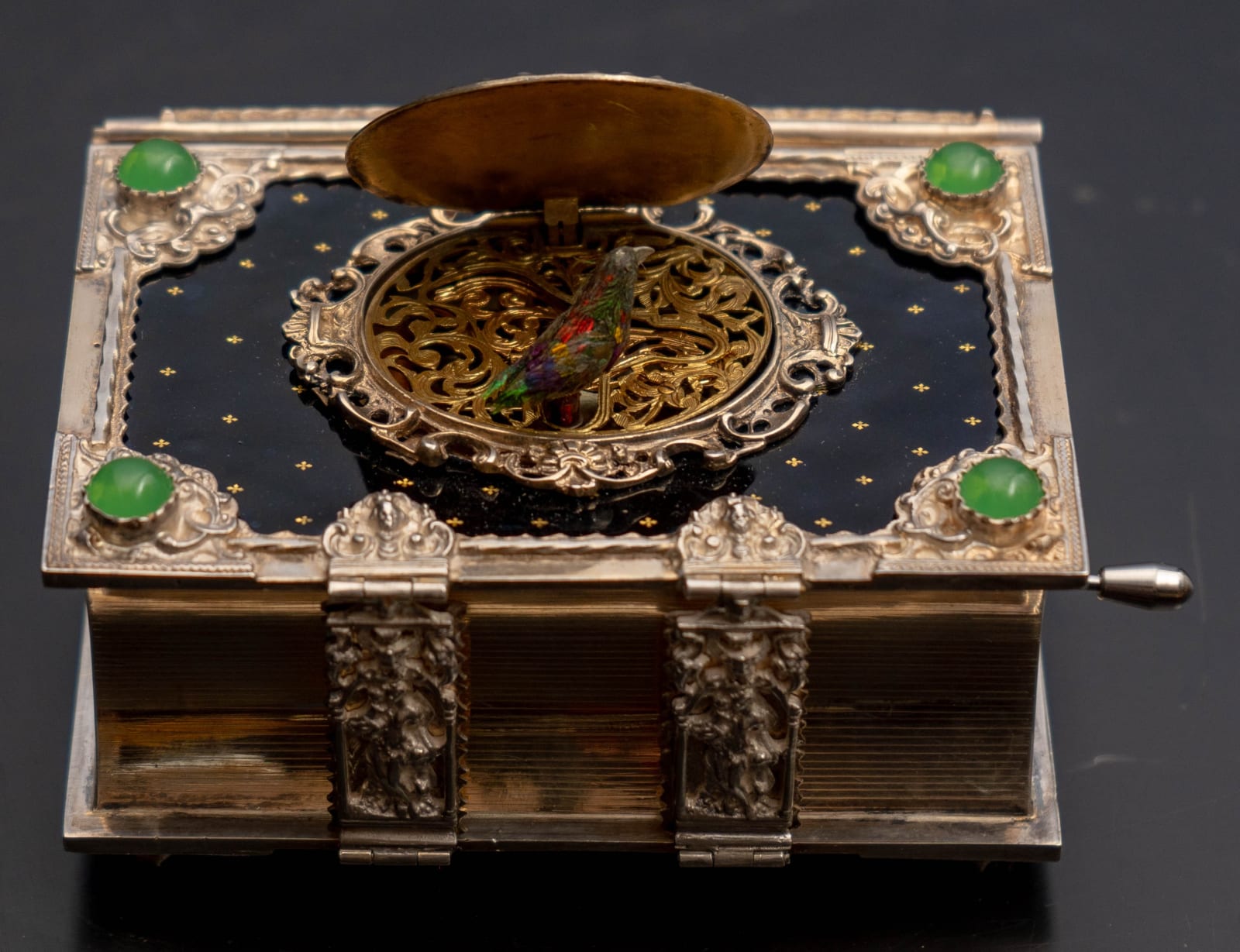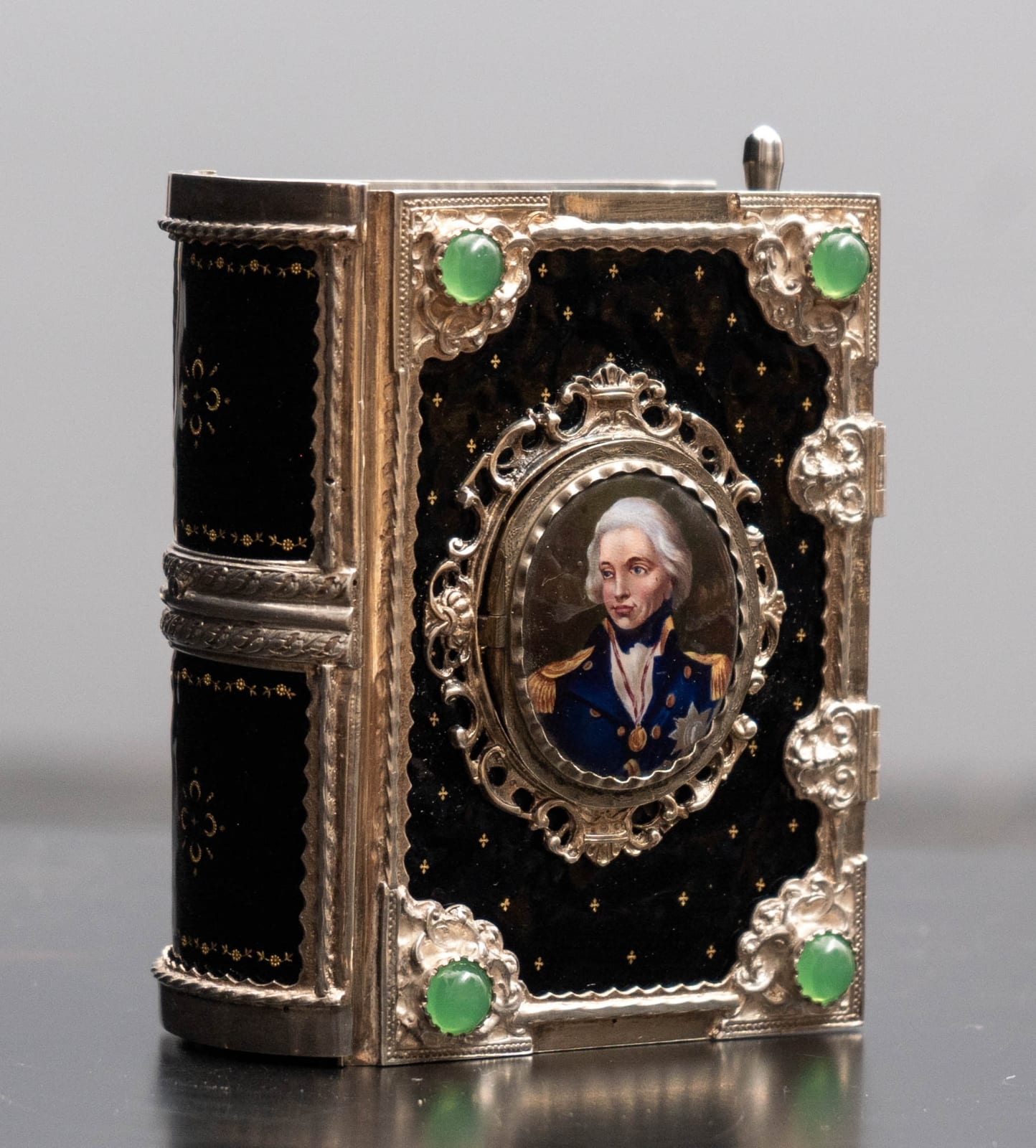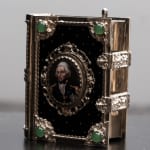attributed to Karl Griesbaum
Further images
A rare German early twentieth century polychrome painted enamelled solid silver singing bird box in the form of a book set with hardstones attributed to Kark Griesbaum, with an enamel panelled spine and decorated simulated clasps, the latched enamelled covers set at the corners with green cabochon simulated emeralds, the blue and gold star-studded front with a central oval lid decorated with a portrait medallion of Vice-Admiral Horatio Nelson, 1st Viscount Nelson, the lid opened by a catch to one side, which when pressed causes the multi-coloured feathered bird to hinge into an upright position, rising through chased and pierced a gilt grille and move from side-to-side while singing a song, with another hinged lid at the underside of the book concealing the winding arbor and going barrel movement playing a single song
The Black Forest, Germany, date circa 1925-35
Height 11 cm, width 9 cm, depth 5 cm.
This handsome singing bird box, shaped as a thick leather-bound book and encrusted with jewelled decorations, is one of a number of ingenious musical automatons. Whilst it is not signed, its quality and style are such, that one can assume it was made by the famous firm of Karl Griesbaum, which became the dominant producer of singing bird boxes throughout much of the twentieth century. The Griesbaum firm was founded in 1905 in the city of Triberg, Schwarz Wald (The Black Forest), Germany. Its founder Karl Griesbaum (1872-1941) was the son of Mathias Griesbaum, a clockmaker, who specialized in making the micro-mechanical parts for hand carved wooden cuckoo clocks. These traditional Black Forest clocks were very popular among the locals, as well as among tourists. By the time he was thirty-three, Karl Griesbaum was running the family workshop and like his father continued to make the small mechanical parts for cuckoo clocks. One day Mr. Rosenau, the owner of a trading firm in Frankfurt that specialized in jewellery and clocks, brought a Swiss singing bird snuffbox for Griesbaum to copy and adapt. For Karl this seemingly insignificant event, became a turning point in his life. This inspired him to start manufacturing music boxes and snuffboxes with singing birds, and to establish the firm of Karl Griesbaum.
Initially, Griesbaum produced three different singing bird boxes The most expensive boxes were made of polished metal, then came unpolished metal boxes, and finally plain brass boxes. At first the cases were bought from a maker in Pforzheim, to the west of Stuttgart; the firm then made the simplest boxes themselves while continuing to buy more elaborate cases in Pforzheim. Eventually all parts of the singing bird boxes were made in-house. The most typical Griesbaum pieces were probably their snuffboxes, particularly those made in a style reminiscent of traditional German silverwork.
In time Karl Griesbaum’s firm was joined by his five children. Mathias, the eldest son, who was born in 1902, was named after his grandfather. Then came three daughters – Amalia, Helena, and Caroline, while the last child, Karl junior was born in 1916. The elder son Mathias studied clock-making in Furtwangen. He then furthered his commercial studies in the nearby town of Karlsruhe, where his grandparents lived and subsequently studied in Switzerland. When he returned to the Black Forest, he brought back with him several specialised machines from Switzerland that would aid the manufacture of singing bird automata. A few years before WWI Mathias Griesbaum left for Berlin, where he started manufacturing mechanical and music souvenir cigar and cigarette-boxes. Mathias had a creative and inventive mind. He was particularly fascinated by the work of former watch and clockmakers such as Jacob Frisard, Frères Rochat, and Charles Bruguier. By careful examination of their singing bird automata, Mathias made a number of detailed and technical drawings of their construction. For instance, for Christmas 1922, Mathias drew up plans of the works of a Frisard snuffbox and a small cage with a bird, which he dedicated to his father.
Having previously purchased cages and other cases for their singing birds from Paris, from about 1923 the firm began making their own cages. The first Griesbaum bird cage was square, with a gilt wooden base, with one bird. Later, larger cages were made, as well as those with two singing birds. In about 1925 the firm introduced a new type of mechanism using whistles, resulting in their innovative whistling figurines. In time, figurines whistling different melodies were produced in many varieties and became one of Griesbaum’s biggest successes. The Griesbaum firm continued working during the WWII since brass was not requisitioned for arms manufacturing. During this period, the firm was still under the direction of Karl Griesbaum senior, with Emil Trischauer as his assistant.
Following the death of the firm’s founder in 1941, Karl Griesbaum’s five children formed an association ‘Karl Griesbaum KG’. After the war, Karl Griesbaum junior headed the firm. Although his brother Mathias returned from Berlin after 1949 to resume working in the family firm, this arrangement was short lived. The two brothers did not get along, and thus Mathias eventually left again to manufacture mechanical and music souvenir cigar and cigarette boxes that he sold in the best tourist gift shops.
The period following WWII was one of prosperity for the business. Karl Griesbaum headed the firm and was assisted by Karl Kiefer. The latter, who had joined the company in 1927 and took care of the accounts, married Amalia, daughter of the firm’s founder. During these busy years, there were twenty-five full employees and several part-time workers. Every month four hundred cages, fifty boxes and sixty whistles were produced. However, toward the end of the 1960s, production slowed considerably. In 1987 Karl Griesbaum left the firm, leaving Karl Kiefer, assisted by his daughter Ursula Mockesch, to continue its management. Nevertheless, it became difficult to find young people willing to learn this demanding skill and so in 1988, after the death of Karl Kiefer, Ursula decided to sell the firm to Siegfried Wendel, proprietor of Siegfried’s Mechanisches Musikkabinett, in the picturesque town of Rudesheim am Rein, which still operates today under the name of Mechanische Musikwerke Manufaktur GmbH.
Griesbaum made a number of book-shaped singing bird box automata. As here, the front page of the book had a central lid which can be opened by a catch, thus activating the bird to arise from the box and then move and sing. The lids of such boxes were usually decorated with a portrait medallion of an unknown historical figure, for instance a gentleman in Renaissance costume. Interestingly, the present lid is decorated with a portrait of one of England’s greatest naval heroes, namely Vice-Admiral Horatio Nelson, 1st Viscount Nelson, 1st Duke of Bronte KB (1758-1805) whose inspirational leadership, grasp of strategy and unconventional tactics brought about a number of decisive British naval victories during the French Revolutionary and Napoleonic Wars. Born in the Norfolk village of Burnham Thorpe in 1758, Nelson was the son of a clergyman. It was his uncle Captain Maurice Suckling who was to influence his future career. In 1770, the young Horatio Nelson, aged only twelve, joined the navy on board his uncle’s ship the Raisonnable during a dispute between Britain and Spain over the Falkland Islands. Nine years later Nelson was put in charge of commanding the frigate HMS Hinchingbroke. He was later charged with taking the young Prince William (the future William IV) to the West Indies aboard HMS Albemarle. When the French Revolutionary Wars began in 1793, Nelson was given command of the ship of the line HMS Agamemnon and was assigned to the Mediterranean. There he took part in the capture of Corsica in 1794 and while directing guns at the siege of town of Calvi he was hit in the face by a shower of gravel and was blinded in his right eye. Nelson first came to fame at the Battle of Cape St. Vincent in February 1797 when his initiative in command of HMS Captain helped prevent the Spanish Fleet from escaping the clutches of Sir John Jervis. At the height of the battle, he captured two Spanish ships, the San Nicholas and the San José, leading the boarding party in person from one to the other. It was extremely unusual for a flag officer to lead such an attack and was even more remarkable given that the second assault was up the side of the large three deck San José which surrendered immediately. This heroic action became known in the Royal Navy as ‘Nelson’s Patent Bridge for Boarding First Rates’. One of Nelson’s few reverses came in July 1797 during the operation to capture the town of Santa Cruz in the Canary Islands. During the second failed attack, Nelson lost his right arm while leading one of the landing parties in an attempt to assault the town.
In 1798, when in command of his fleet of fourteen ships, he destroyed a French fleet of seventeen in the Battle of Aboukir Bay at the mouth of the Nile. This was the most overwhelming victory in the age of sail. All the key elements of the Nelsonian system were present including personal courage, tactical genius and the sharing of his innovative tactics with his captains. Following the Battle of Aboukir, Nelson was based at Naples where his celebrated affair began with Lady Emma Hamilton, the wife of the British ambassador. Nelson was only second in command of the fleet sent against Denmark in 1801, but after famously turning his blinded eye to the telescope ordering him to retreat, he carried the assault on Copenhagen to a successful conclusion. After this success he was promoted to Vice Admiral and took command of the Mediterranean Fleet in 1803. Finally at the Battle of Trafalgar on 21st October 1805 with twenty-seven ships, he inflicted a crushing defeat on the numerically superior Franco-Spanish fleet comprising thirty-three vessels, of which only seventeen escaped. However, the same day, while standing on deck his ship HMS Victory, Nelson was shot by a musket ball by a French sharpshooter and died soon after, but in the knowledge that he had achieved another famous victory. Nelson’s passion for risk taking lost him the sight of an eye, an arm and eventually his life but, together with his remarkable charismatic leadership skills they created a legend that continues to inspire.
The present portrait medallion is based on an iconic likeness of Nelson by the English portrait painter Lemuel Francis Abbott (1760-1802), 1797. Over the course of several years Abbott painted over forty similar portraits of Nelson. As here, all showed the hero in the rear-admiral’s uniform wearing the Star and Ribbon of the Bath and the Naval Gold Medal, awarded for his victory at the Battle of St. Vincent (1797). The original completed portrait was painted for Captain Locker of the Greenwich Hospital in 1797, shortly after Nelson had lost his right arm in the Battle of Santa Cruz, Tenerife. Of the many subsequent versions, one was painted for Horatio’s wife, Lady Nelson, which is now in the National Portrait Gallery, London. When deciding upon a subject to adorn the present singing bird box, the firm of Griesbaum may have based their likeness of Nelson on one of the existing oil versions or more likely on an engraving of this iconic image. The present musical box dates to the early twentieth century, most likely during the years between the First and Second World Wars. Since Britain and Germany had been at war against one another, it is likely that Griesbaum was especially commissioned to execute the present box for an English client and most probably as a token of peace between the two nations.





